In nearly three circumnavigations of the globe and hundreds of thousands of overland miles, I have never had a puncture—not a single tire flattened by rock, stick, screw, or nail. This is not to say I have not experienced a flat or two, but it has usually been in sand dunes (a lost bead) while running very low air pressure. This does not necessarily merit bragging rights, as I have been entirely bemused by my luck. However, is it luck, or have variables contributed to my good fortune? There are critical factors that influence a tire’s puncture-resistance and tractive performance. For this comprehensive review, we will expose the side-by-side results of seven leading all-terrains.
Tire Performance for Overland Travel
While reliability is arguably the greatest consideration for an adventure driver, I would submit that performance shares an equally critical role. During my earlier travels, thoughts were drawn towards how my equipment would hold up. However, those concerns have since been partially replaced with a focus on how the gear will perform. This applies to not only my vehicle and various modifications, but also to my tires. They must be durable, reliable, and work really well when things go sideways.
From a romantic viewpoint, overland travel is a series of endless remote dirt roads. However, we all know that long sections of pavement and graded gravel separate us from those majestic backcountry photo opportunities. For example, a trek to Nordkapp, Norway, will be nearly all pavement, but odds are good that it will be snowy or wet pavement. For this reason, an all-terrain is typically the best option for transcontinental travel. All-terrain tread designs offer reasonable performance for many scenarios, and are very effective for those long transit stages on pavement.
Evaluating a tire’s performance is multifaceted and complex, with aesthetics rarely far from the bottom of the consideration set. A puncture is typically no more than a minor inconvenience, but rounding a corner at speed and hitting ice or wet pavement could be a trip-ending event. Performance influences safety, and this evaluation focuses on how effective a tire is when we need it most.
Tread Design
All-terrain tire development has gone through a renaissance in recent years. The use of computer-aided design (CAD), finite element analysis (FEA), and advanced rubber compounds have resulted in exponential improvements. As a result, it is possible for all-terrains to not only look great, but also to perform effectively on- and off-pavement. Tread design has a significant influence on traction, with components including lug void space, lug shoulder shape, siping, and lug integrity. Void space primarily assists in the evacuation of mud, snow, and water, and allows the lug face to present a clean biting surface on the next revolution. The shape of the lug and void space contributes to how the tire holds a line in mud and snow. Interrupted void channels improve slope-holding (lateral slip) for a cambered sidehill and down/uphill (longitudinal slip) in mud and snow, but reduce the effectiveness of water evacuation. The angle of the lug shoulder contributes to stone retention and lug integrity. An angled shoulder will help reduce stone retention and reduce tearing and chunking of the rubber.
Sipes are thin slits in the face of the lugs. They provide additional biting edges on the contact patch and significantly improve wet surface and snow/ice traction. The effectiveness of these hairline cuts should not be undervalued, as they affect mechanical keying (defined below) and increase traction on other surfaces as well. However, siping can impart compromises, which include accelerated wear and tearing of the rubber. There are pros and cons to siping, but the trade-offs are worth it.
Glossary of Terms
Adhesion
Adhesion is realized during the period of contact between the tread and the tractive surface. It is most relevant on dry surfaces, and diminishes rapidly once moisture (as frozen or liquid water) is introduced. A tire’s rubber compound, which is a cocktail of natural and/or synthetic rubber, carbon black, silica, sulfur, and other agents, has a great influence on adhesion. For example, when driving on Moab’s slickrock, how well a tire “sticks” to the terrain is a property of adhesion. The same applies on the road, where effective adhesion improves grip while cornering, braking, and accelerating. With road racing tires, such as those used in Formula 1, the focus is on maximizing the tire-to-track adhesion and micro keying.
Having said this, tire manufacturers have been hard at work perfecting their rubber-carbon-silica cocktails and most currently utilize a proprietary compound. For example, Falken drew on their years of experience with high-performance racing tires when they engineered the WildPeak rubber, with impressive results.
Deformation
How a tire’s carcass and tread lugs deform provide several notable traction and flotation benefits. Deformation allows the tire to fold around and conform to obstacles such as rocks, ledges, ruts, and roots. This increases the contact area, which allows for maximum adhesion and mechanical keying and is critical for traction on irregular surfaces. As you might expect, deformation is one of the key benefits of reducing a tire’s air pressure. Lug deformation, which is influenced by rubber compound (hardness) and tread block design, is also an important factor. As the tread encounters an irregular surface, such as a rock, it can deflect, shift, and partially interlock with the obstacle’s edges. However, deformation, as with most things, can come at a cost. A carcass that is too flexible may not support a heavy payload properly, which can cause the tire to overheat and possibly fail. It may also be less resistant to punctures. Lugs that are too soft or compliant can tear or deflect completely under the input torque. In short, we want a tire that is durable, yet compliant in rough terrain. Some manufacturers, such as Goodyear, have addressed this by utilizing materials such as Kevlar into the sidewall.
Mechanical Keying
There are two forms of mechanical keying: micro and macro. Macro keying is the interface between the lugs and a traction surface. The tread blocks interlock with irregularities in the terrain, which aids the vehicle in climbing the obstacle. It can be best compared to a rock climber ascending a cliff wall by interlocking his or her fingers with small cracks in the surface. Micro keying, the deflection of the rubber itself, is equally important. It can be described as the ability of the rubber to receive an impression, on the micro level, from irregularities in the surface. The rubber’s “softness,” which is typically measured with a durometer, directly influences micro keying. As with deformation, a soft rubber compound may come with compromises. If the rubber is too soft, lugs may tear, or the tread face may smear away. Heat buildup and reduced longevity are also factors.
Steering Attributes
Directness is a reflection of the vehicle’s response to the main shaft angle, which is the driver’s rotation of the steering wheel. A tire that responds directly to that input would be a positive outcome, while a response that is delayed would be negative. On-center feel is also a measure of directness, but specific to the effort of maintaining a straight-line course. If the tire is vague on-center, constant correction will be needed from the driver, which can contribute to fatigue.
Handling Characteristics
Handling was a primary consideration for test evaluators, and was defined with a myriad of descriptors. Line holding is the ability of the tires to be set to a specific steering input and hold the intended course. Matching is similar, but reflective of the grip demonstrated by the front and rear tires. A common mismatch might be good front axle grip (line holding), but the rear may come into oversteer sooner than acceptable. Step-out is the reaction of the vehicle when encountering small surface irregularities in a curve (corrugations are a great example). If the tire lacks grip and compliance it will step-out, or slip off-line with each impact. Overshoot is when countersteer input is provided by the driver but the grip is so low or unpredictable that the vehicle swings past an intended course (usually in a straight line). Predictability is one of the most important attributes, as it demonstrates the driver’s confidence in the tire to perform consistently as expected.
Testing Considerations
It will be easy for some to dismiss the asphalt components of this test as irrelevant. However, as I mentioned, pavement performance is of equal importance to that of dirt results. In fact, the Editor’s Choice and other top scorers in this test have proven that an all-terrain can excel on the road and trail. Having said this, I find it surprising that other tire tests have avoided pavement evaluations altogether. Joe Bacal, our lead evaluator, emphasized the importance of repeatable pavement tests. He said, “OHV enthusiasts typically believe that dirt performance is all that matters, and as a result, their trucks handle poorly on the pavement and on the trail. A tire that performs well on the track can also do magic on the trail. As a lead evaluator for Toyota, I expected a tire to work well everywhere.” Our goal was to find a tire that performed well everywhere, and we did.
A key factor in any comparison of this nature is to create repeatable tests and evaluate the product on an identical platform—rather than on a mixed fleet of staff vehicles. To address this we sourced two identical 10th Anniversary Edition 4-door Jeep Wrangler JKs. They were left in stock configurations and with factory 8.5- by 17-inch wheels. For road and track testing, we rented the Yavapai County fairgrounds near our office in Prescott, Arizona. Facilities included large asphalt parking lots, long sections of road-quality pavement, and an equestrian racetrack.
Testing Notes
Data Collection
This test would not have been possible without the G-Tech/Pro metering device and the generous on-site support from its creator (and Overland Journal subscriber), Jovo Majstorovic. In addition to developing the G-Tech, Jovo is considered a tire expert. His professional assistance and input greatly aided our testing methods and data collection. The G-Tech/Pro is a GPS vehicle dynamics measurement tool that mounts to the windshield. It was used to record track times, g-force, speed, and more.
Lead Evaluator
The primary test driver was Joe Bacal. Having worked for nearly a decade on model development with Toyota and other manufacturers, Joe is regarded as one of North America’s foremost four-wheel drive performance evaluators. One of his primary responsibilities for Toyota was testing tires for their four-wheel drive platforms. In addition to his OEM experience, Joe is a Baja 250, 500, and 1000 winner with Team Lexus.
Tire Selection
For this review we chose seven of the more popular all-terrain tires on the market. The lineup includes current offerings from BFGoodrich, Cooper, Goodyear, General Tire, Dick Cepek, Falken, and Toyo. All tires were Light Truck (LT) 265/70 R17 with an E load rating.
On Road
Limit Handling: The limits of vehicle dynamics can be evaluated with a professional test driver, where extreme inputs are presented, such as braking in a turn, an emergency lane change, or a lift-throttle oversteer. These extreme inputs were performed to document the limits of each tire’s performance.
Braking: Emergency braking from 60 mph to full stop. ABS was disabled and the test was performed three times. The G-Tech Pro measured exact point where brakes were applied and the point where the vehicle stopped. Results were averaged and additional comments were recorded for straight-line stability, hop, and predictability.
Slalom: With stability systems disabled, the Jeeps were pushed through a set of cones placed at 50-foot intervals. Three runs were performed with each tire and the time/speed results from the G-Tech were averaged. The slalom provided significant insights into lateral grip, directness, carcass and lug deflection, and predictability.
Skidpad: Safety cones were set up in a 100-foot circle. Stability systems were disabled and each tire was driven as quickly as possible for a minimum of three laps, or until the lap times declined. The G-Tech was used to collect lap times and provide insights into tread deflection and rubber tearing, as well as lateral grip, heat buildup, and line holding.
Wet Cornering: This was a 90-degree wet corner, run at the fastest speeds possible (average of 45 mph). Tire understeer caused the Jeep to push off the course, while oversteer required corrective input. Evaluative considerations were lateral grip, effectiveness of rubber compound, tread design, and siping.
Highway Test: An identical stretch of highway was driven with each tire. We noted noise, vibration, and harshness (NVH), along with wander, ride quality, and stability. Tires that are smooth, quiet, and comfortable on the highway will reduce driver fatigue.
On Trail
Dirt Oval: We utilized the fairground’s equestrian 1.5-mile dirt oval, which included lightly banked turns, mild corrugation, and erosion lines. This repeatable and controllable test, which we drove at high and low speed, provided insight into performance on variable-surface dirt roads. Considerations were lateral grip, harshness, oversteer, understeer, emergency braking on dirt, directness, line holding, and predictability.
Rut Test: A course was set up through a twisty section of decomposed granite. The objective was to drive the course with the majority of the vehicle’s weight resting on the outer edge of the tire. This test was used to evaluate sidewall grip, deformation, shoulder lug traction, and to a lesser degree, mechanical keying.
Rock Climb:
To evaluate low-speed tractive performance, adhesion, mechanical keying, and deformation, we found a steep, 38-degree granite slab with variable surface imperfections. A chalk line was drawn to keep each tire on the exact track, and front and rear locking differentials were engaged. Utilizing threshold throttle input for the slowest speed possible, we inched the JK up the face. If the tires lost traction and the vehicle ceased forward progress, a measurement was taken from a predetermined point to the center of the front wheel. The test was decisive: several tires cleared the top of the slab and received a 100-percent score, while others lost traction and failed to complete the climb.

Additional technical data collected included the average weight needed for balancing, air pressure required to seat the bead, durometer measurement, tread depth, weight, and deformation at variable air pressures.
BFGoodrich All-Terrain T/A KO
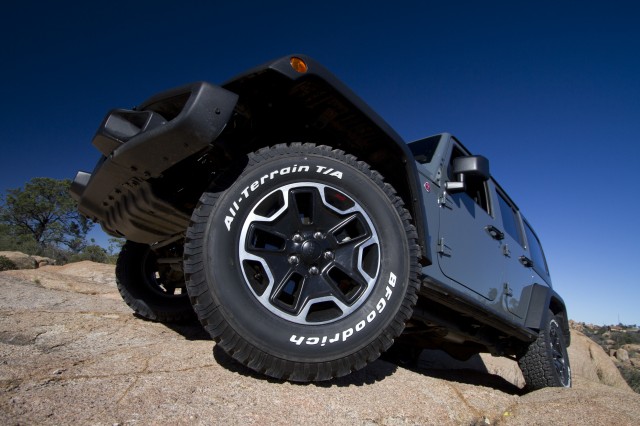
BFGoodrich (BFG) has been a stalwart brand in the overland and 4WD communities for four decades. The All-Terrain T/A, which was released in the late 1970s, claimed countless awards and desert racing championships. I have used BFG tires for years and several hundred thousand miles, and currently have a set on our project Land Rover Discovery. Despite the reliability I’ve experienced with this tire, technology has advanced well beyond their current designs. As a result, these classic standbys are fading into the past.
On Road
In the highway evaluation the All-Terrain was busy and noisy. The Jeep tended to follow grooves and generally imparted a harsh ride with excessive noise. The tire also required the highest average weight to balance (8.06 ounces). The T/A provided reasonable stopping distances and finished towards the middle of the pack in the emergency braking test. On the slalom track it had the slowest overall time, with less-than-impressive lateral grip, and required significant steering input for directional change. Skid pad times were at the lower end of the pack, and calculated lateral g-force was .67. At the end of the test, the shoulder of the outside front tire was showing major tearing and chunking and was nearly shredded. Once the asphalt turned wet, the speeds and control in the 90-degree corner dropped even further, resulting in the poorest performance of the test.
On Trail
The T/A continued to struggle in the dirt. There were significant delays in responsiveness and excessive steering wheel input was required to initiate directional change. Lateral grip on the dirt oval was recorded as weak, which induced oversteer and slow recovery during countersteer. Damping was good on the dirt, with less step-out on corrugations than average and better overall comfort. We did note that the tire was linear and lacked surprises—even with less overall grip it was consistent and predictable. On the rock climb the BFG demonstrated good lug deformation and keying, but lacked adhesion and ultimately failed the climb. It recorded the shortest climb height of the units tested. bfgoodrichtires.com, 877-788-8899
Pros:
Three-ply sidewall
Good damping and deflection on dirt
Classic all-terrain design
Cons:
Poor adhesion
Poor wet traction performance
Excessive lug chipping and tearing
Editor’s Note:
Although we would have like to have tested BFG’s newest AT, the KO2, it was not available at the time of testing in early April. We will provide a full review of that tire in the coming months after we get a chance to put the prerequisite miles on a set. Short term testing was conducted in Baja and reported in the Winter issue of Overland Journal.
Dick Cepek Fun Country
Dick Cepek, a passionate outdoorsman, purchased a Land Rover in 1958 to explore the California deserts. Unsatisfied with the tire options available, he tracked down Armstrong, who produced a tractor tire he felt was suitable for desert terrain, and talked them into making one that was DOT approved. It was introduced in 1961 and christened the Hi-way Flotation tire. Dick Cepek is one of the original names in recreational four-wheel drive tires and their product line still reflects this ethos. The Fun Country tire is an aggressive all-terrain with large shoulder lugs and wide tread spacing.
On Road
The Fun Country performed in the upper half of the pack in the high-speed asphalt testing, which was surprising given its aggressive pattern. Despite recording faster times, it required significant driver input and correction. Grip felt non-linear and resulted in unsettling the Jeep and poor repeatability; we clipped more cones with this tire than with any of the others. In the braking test, straight-line stability and traceability was the lowest in the group. On the highway the Fun Country exhibited the poorest NVH; it followed most grooves and required active driver intervention.
On Trail
On the oval track the Fun Country displayed similar characteristics. It was busy, which resulted in poor predictability and near-constant driver correction. Grip was acceptable at lower speeds, but irregularities in the surface caused the rear to step out slightly. Joe described the high-speed performance as non-linear and with a two-stage grip effect. There was an initial delay (low grip) followed by rapid grip as we scrubbed off speed during the slide. As speeds increased, driver confidence dropped. The result was the lowest speeds in the group. On the rocks we experienced good mechanical keying from the larger lugs, but carcass deformation and adhesion were low, which resulted in a failed climb. dickcepek.com, 330-928-9092
Pros:
Good lateral grip on pavement
Mechanical keying on rock from large tread lugs
Deep tread
Cons:
Failed rock climb
Unpredictable at high speeds on dirt and pavement
Poor straight line braking performance
[Need image captions]
Falken WildPeak A/T
Though Falken is new to the all-terrain segment, they have a rich history in heavy-duty truck and high-performance street tires. This marriage of engineering acumen has resulted in the most unique tire in the test, one that exhibits a number of class-leading attributes. Since its introduction we have collectively put over 30,000 miles on various sets of WildPeak A/Ts. They are currently mounted on the Editor’s Mobile Office Tacoma project as well as on our long-term Land Rover LR4, and we have experienced no punctures or failures on either vehicle.
On Road
On the highway the Wildpeak A/T provided a clean and smooth ride, though it did have a slightly vague on-center feeling. Where the Falken showed its racing roots was on the high-speed asphalt courses, where it revealed several surprises on the stopwatch. In the slalom course it achieved the fastest single pass through the cones—a 6.97-second run. However, the tire also exhibited the greatest spread in run times, which translated to predictability concerns. Lateral G performance on the skid pad was in the middle of the pack, primarily due to fall-off of grip as the tires warmed after the second lap. The compound exhibited impressive adhesion properties but heated quickly. A comfortable and quiet tire on the highway, yet still ideal in an emergency lane-change scenario.
On Trail
The Wildpeak also exhibited wide-ranging results on the dirt. It offered class-leading dry-rock traction but only average effectiveness on gravel at high speeds. During the granite climb test the tire’s rubber compound performed magic. Though carcass deformation was average, we were able to climb, back down, stop in the middle, and climb again. When considering the tire’s rather tame appearance, we were extremely impressed. We were also pleased with the WildPeak’s durability, experiencing minimal smearing and no chunking or tearing of the lugs. Though it is only a two-ply design, its sidewall was one of the thickest in the test. Quality of construction is excellent and we found the carcass to be extremely durable. During the high-speed dirt testing it was predictable and linear, and ranked near the top of the class with regard to overall grip. However, it was noted at the upper limits of speed in the dirt oval that the tire did trend towards oversteer. falkentire.com, 800-723-2553
Pros:
Class-leading dry rock traction
Excellent initial grip on dry pavement
Smooth and quiet on the highway
Cons:
Vague on-center feel
Trends towards oversteer on dirt
Fast wearing due to soft compound and lug pattern depth
General Grabber AT2
Over the past few years General Tire has made an aggressive move into the SUV and off-highway market. In 2011, their race-inspired Grabber (mounted on the
FabSchool-General Tire Ford Raptor) brought home a class win from the grueling 14-day Dakar Rally. Editor Chris Collard, who was the team’s media manager, said, “Aside from a bead-locked set we used in the Atacama dunes, we finished the entire 6,500-kilometer race with the same tires we started with.” The AT2 has a classic five-row tread pattern featuring interlocking lugs and generous siping. The Overland Journal team has been abusing a set of AT2s for over a year and has not experienced any punctures or other failures. Select sizes meet severe snow service requirements (RMA and RAC) and all sizes are studdable.
On Road
On the highway the Grabber provided middle-of-the-pack ride quality. Noise levels were slightly higher and it had a notable firmness over road irregularities. On the track, as speeds and need for grip increased, the General impressed. It turned in the second highest lateral G reading on the skid pad, and was better than average on the slalom, which instilled an overall feeling of control and directness. Wet traction was low due to limited overall adhesion and siping. Braking distances were some of the longest in the test, with a 171-foot average. These performance disparities can be explained by the unit’s love of heat. The Grabber improved in every test as the laps ticked by. The last braking run was the shortest; the fourth skid pad lap was the fastest.
On Trail
The General was noted for precision and directness on the high-speed dirt oval. The front and rear were well matched, which resulted in no surprises to the driver. The Jeep responded quickly to steering input and exhibited limited oversteer on lift-throttle. Countersteer brought the vehicle back from oversteer scenarios, though we experienced a slight overshoot from the correction. Unfortunately, the tire’s solid performance at high speed did not translate to the rock climb test. The carcass and lugs provided limited deformation and adhesion, reflecting the harder-than-average durometer rating. The tire is clearly designed for long life (60,000 mile warranty), but sacrifices some dry rock performance. generaltire.com, 800-847-3349
Pros:
Good lateral grip on pavement
Direct and accurate at speed
Excellent grip at speed on dirt
60,000-mile warranty
Cons:
Failed rock climb
Firm ride quality
Poor straight line braking performance
Needs heat in the tire for best results
Goodyear Wrangler All-Terrain Adventure

Goodyear is a quality tire manufacturer who has placed a recent emphasis on durability and puncture resistance. Their Kevlar and SilentArmor technologies have fostered a deserved reputation for reliability on the trail. The Wrangler All-Terrain Adventure Kevlar was chosen for its multi-condition design, light truck construction, and DuPont Kevlar carcass. We have used these tires extensively on various Jeep vehicles and have experienced no punctures or other damage.
On Road
On the highway the Wrangler provided a quiet ride, but did exhibit more low-frequency vibration than other tires in the test. With limited lug deflection and a compact tread pattern, the tire proved responsive at higher speeds and provided a very direct feel. The Wrangler also scored well on the various asphalt tests, where it turned in the fastest average times on the slalom track and the highest lateral G on the skid pad. Emergency braking was also excellent, with solid straight-line stability and the second lowest average stopping distance in the group. Given the tire’s shallow tread depth and compact lug configuration, the road results were not surprising.
On Trail
Though the Wrangler did well on the pavement, its dirt performance was the poorest showing in the test. This might seem obvious considering it was the most street-biased tire in the evaluation. However, this did not always correlate to other tires, with the test winners performing well in both road and dirt tests. In general, the Wrangler lacked grip on the dirt and recorded the slowest speed on the dirt oval. Ride comfort was good, but responsiveness felt vague and it was slow to recover from oversteer and was prone to overshoot. The tire would snap past the neutral position once countersteer was applied. Overall, it provided the lowest level of driver confidence in the test group. Poor mechanical keying, along with the hardest compound in the test (68 durometer) resulted in it failing the granite rock climb. goodyear.com, 800-321-2136
Pros:
Quiet and stable on the road
Fastest slalom time
Highest lateral G on skid pad
Excellent braking characteristics
Cons:
Limited grip in all dirt conditions
Failed rock climb
Overshoot after countersteer
Toyo Open Country A/T II
In 1966, Toyo was the first Japanese tire manufacturer to establish a subsidiary in the United States. Though they initially focused primarily on passenger tires, the introduction of their Open Country line in 2003 planted them firmly in the off-highway sector. Acceptance of the Open Country amongst enthusiasts grew rapidly, particularly when their desert racing campaign, which included a multi-year sponsorship with Robby Gordon, started bringing home class wins from events such as the highly-revered Baja 1000.
On Road
On the highway the Open Country exhibited low NVH, which is reflective of its all purpose tread design and advanced noise-cancelling. The Open Country provided the lowest overall stopping distance and the most consistent braking results. However, the Toyo struggled with regard to lateral grip on the slalom course and skid pad tests, where it posted the slowest average times on both. The tire tended to heat up quickly and exhibited rapid tread deterioration at the shoulder, as well as smearing and tearing across the entire tread face. Speed through the wet corner was average.
On Trail
Performance improved markedly on the dirt oval, where the tire displayed good line-holding properties and minimal oversteer. Subtle input to the steering wheel resulted in a very linear response and excellent predictability, which instilled a high level of driver confidence. Front to rear matching was also good, and the tire reacted well to countersteer with minimal overshoot. On the rock climb the Open Country was one of the few to complete the obstacle. This can be attributed to the rubber compound’s soft durometer rating, positive mechanical keying, and excellent deformation of the lugs and carcass. Overall lug integrity was average, with no chunking or chipping. toyotires.com, 800-442-8696
Pros:
Good line holding on dirt oval
Excellent carcass and lug deformation
Smooth and quiet on highway
Excellent on- and off-pavement braking performance
Cons:
Lowest overall pavement performance
Poor wet traction performance
Shallow tread depth
Cooper Discoverer A/T3 (Editor’s Choice and Value Award)
Cooper’s Discoverer A/T3 is a thoroughly modern tire. Positioned as a dedicated all-terrain, it stems from technologies such as advanced CAD design and FEA engineering. We have put over 10,000 miles on various sets of A/T3s, including a crossing of Australia with a 200 Series Land Cruiser, a traverse of Western Canada in a 110 Defender, and considerable abuse during military training in our LJ78 Land Cruiser. Our testing has resulted in no punctures or failures.
On Road
On pavement the A/T3 behaves more like a performance tire. It had consistently short braking distances and recorded the second fastest speed in the slalom course. Grip improved even more on wet asphalt, where the Cooper clocked the fastest speed—so high that Joe suggested we stop the test for safety reasons. On ice and snow we have found traction is nearly as effective as a winter tire. The A/T3 demonstrated superior ride quality, NVH, and skid pad handling; it cannot be overstated how well these tires perform overall on the pavement. While proprietary engineering data from Cooper was not available, we concluded that the excellent pavement performance was a result of high adhesion (softer durometer), lug integrity and stability (shouldered lug design), and aggressive siping.
On Trail
The Cooper was the high-speed champ on the dirt. On the dirt oval we were able to manage controlled, four-wheel drifts at speeds in excess of 75 mph; this was 15 percent higher than the second best performer. The tire responded well to small inputs of the steering wheel, was direct, and inspired confidence. The prodigious grip allowed for effective countersteer and braking on the loose gravel surface. It has a tapered lug shoulder, which resulted in negligible stone retention; a welcome attribute when compared to older lug profiles. We also found lug integrity to be high, and experienced limited chipping or chunking during the test period. The Cooper performed admirably on the rock wall and rut section, but the rubber composition did demonstrate some compromises. Though adhesion was average, the tire ultimately completed the rock face climb through a combination of mechanical keying and excellent deformation. Carcass flexibility and conformity is better than average. coopertire.com, 800-854-6288
Pros:
High-speed control and predictability on dirt
Greatest range of performance
Best wet-pavement traction
Cons:
Lacks three-ply sidewall
Conclusion
We had several goals with this test: to conduct repeatable on- and off-pavement evaluations that pushed the limits of grip, have each unit evaluated by a professional driver (one skilled in tire testing for off-highway vehicles), and provide definitive results that would allow our readers to select a tire with confidence. We were fortunate to have Joe Bacal, owner of TJ Grey Performance Driving, participate as chief evaluator. One of Joe’s jobs with Toyota was to test tires for vehicles like the FJ Cruiser and Tacoma. As a result, this is not just another glossy tire test with highly subjective data. This test is exactly how an OEM would evaluate tires and the result was decisive.
With many of these tests we were surprised by the results, the outcome often challenging years of assumptions or general industry belief. This test was particularly compelling, as the conclusions rocked those long-held opinions. We all expected the BFGoodrich to be a leader on the dirt, but it struggled against more modern designs. We expected the Dick Cepek to excel at the rock climb, but it failed to make the top. As a result, it is clear that an all-terrain must be a combination of a multitude of critical design considerations, including a flexible and durable carcass, advanced tread face design, and most important, rubber composition.
On Road
For overall road performance the Goodyear Wrangler was the champion. It achieved the fastest times through the slalom and skid pad, recording a .77 lateral G. However, our focus extended beyond road performance and the Goodyear struggled in the dirt. This left the Cooper and Falken as contenders. The Falken has tremendous grip, so much so that Joe commented on the difficulty achieving consistency from run to run. Through the slalom the Falken had the fastest time of the day, evidence of the tire’s performance rubber compound. However, the Cooper was the most consistent and nearly as fast as the Goodyear in all categories. The Cooper also smoked the competition on wet traction, yielding so much grip that we had to limit the 90-degree turn speed to 55 mph, almost 20 mph faster than the BFGoodrich. On the highway the Cooper also yielded the best score for NVH and overall comfort.
On Trail
While on-road performance is important, we were looking for the tire that worked the best in both pavement and dirt environments. Once on the high-speed dirt oval, the street-biased Goodyear faded into the dust, leaving the Cooper, General, and Toyo in the running. All of these tires had positive grip, with the Toyo having good line-holding, but lacking in on-center feel and directness. The General also held a line well at speed, but struggled with small oversteer and slight overshoot. In the end, the Cooper was the overwhelming champ at speed. After a controlled 75-mph drift Joe summed the tire up as “ridiculously fast.” The Cooper is smooth and effective at speed, with limited oversteer and no notable overshoot upon countersteer. On the rock climb, the Cooper was successful, along with the Toyo and Falken. However, it was the Falken that proved to be the champion on the dry rock, outperforming all other contenders in adhesion.
Editor’s Choice and Value Award
The Cooper Discoverer A/T3 was the overwhelming winner. As the lowest-priced offering, it is also a genuine value. The cost saving is no doubt a result of the company being one of the world’s largest tire manufacturers. The A/T3 was the second fastest through the slalom and wet corner, third fastest through the skid pad, and had the third shortest braking distance. On the highway the Cooper was direct, quiet, and smooth—a tester favorite for long-distance cruising. One would think that all of this pavement performance would result in a lackluster dirt showing, but the Discoverer was an animal on the dirt oval and provided huge driver confidence. This directly translates to improved safety for an overland traveler. The Cooper was also one of the three tires that climbed the rock face successfully.
Each of these tests shakes our assumptions of product performance and reorders our knowledge of what works and what does not. For nearly 20 years I have run BFGoodrich All Terrain tires on my vehicles, as they were nearly universally accepted as the performance leader. However, a lot has changed in the past two decades and there are now new champions. My hope is that these new tires prove as puncture resistant, and that my luck still holds. Either way, we promise to report back on how each tire survives the long haul.


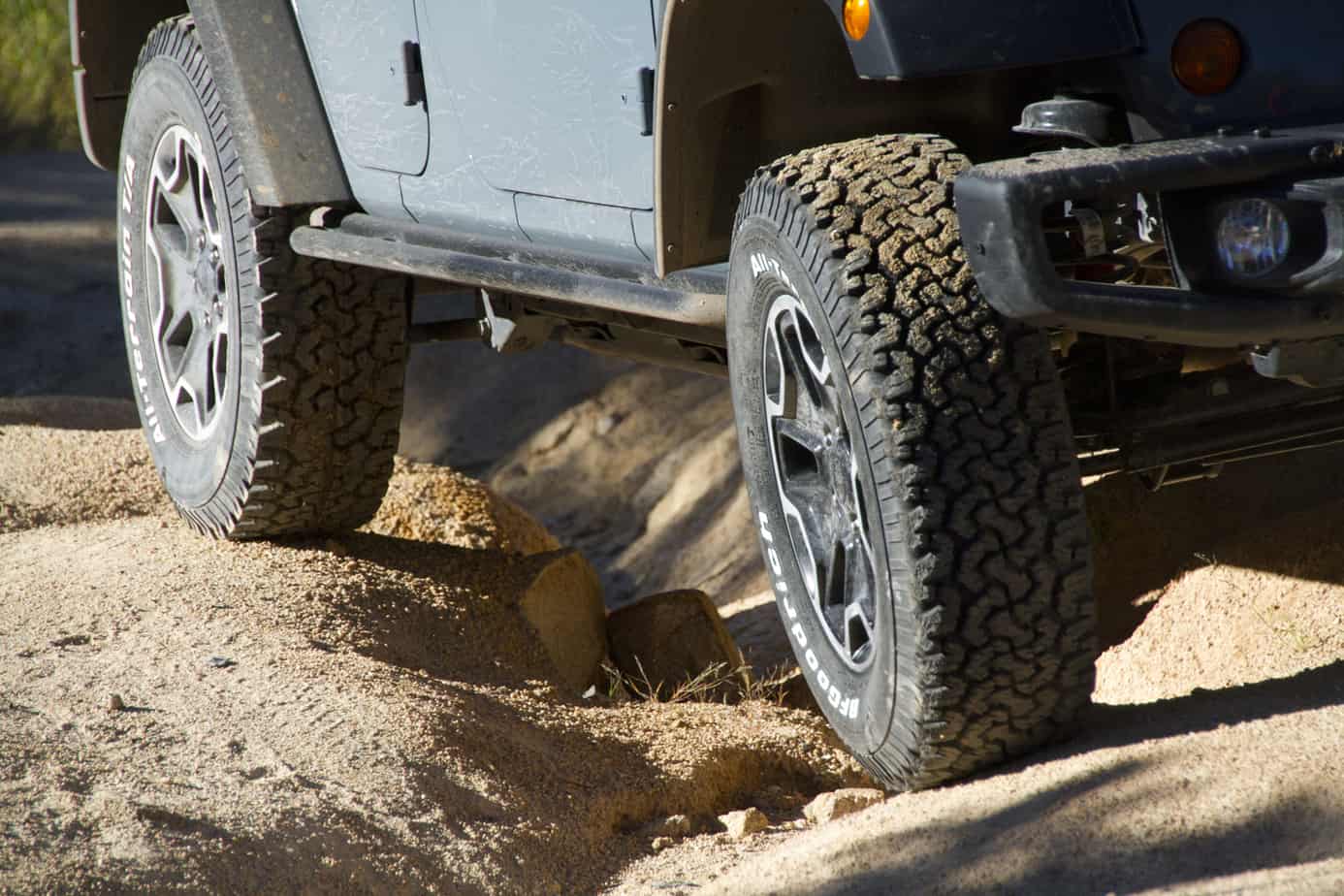
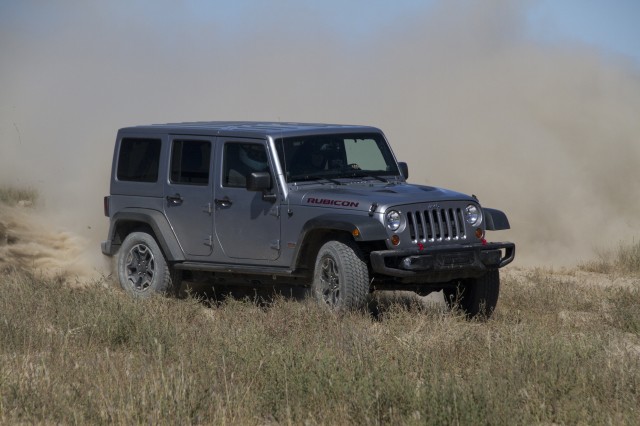


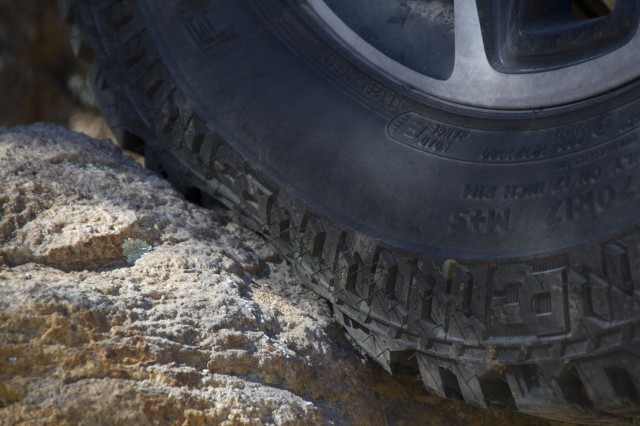
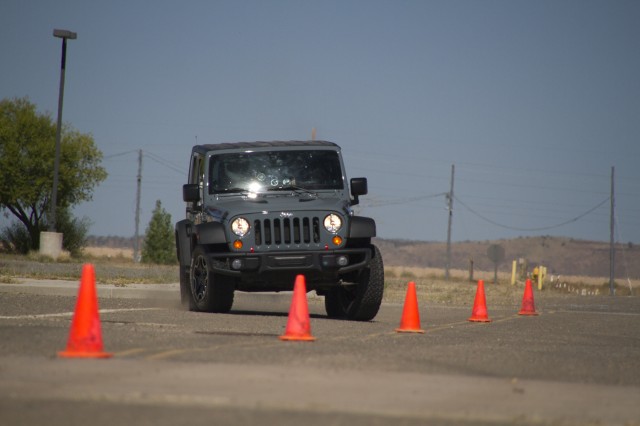




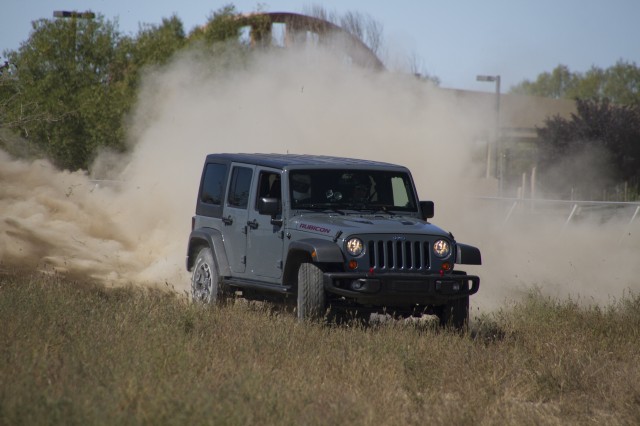
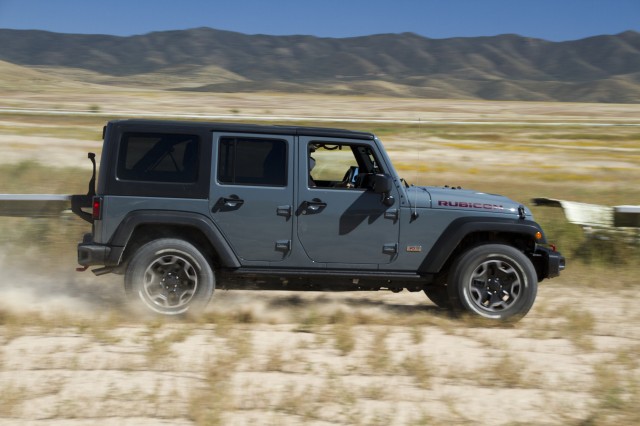
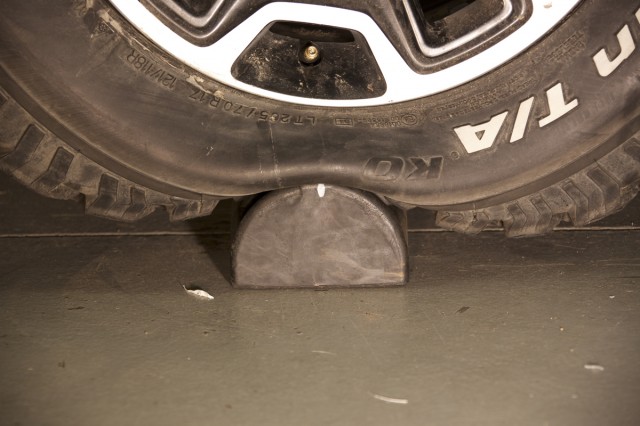
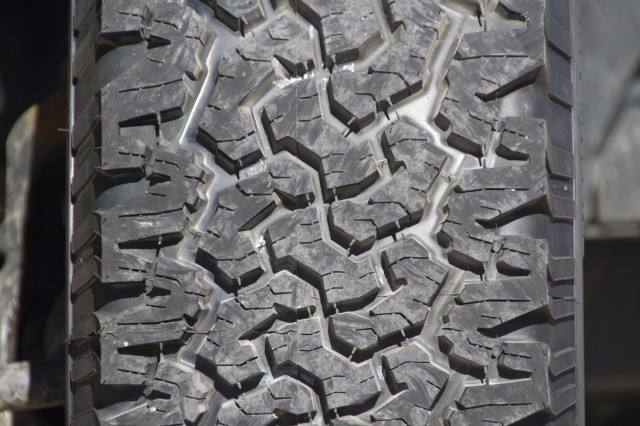
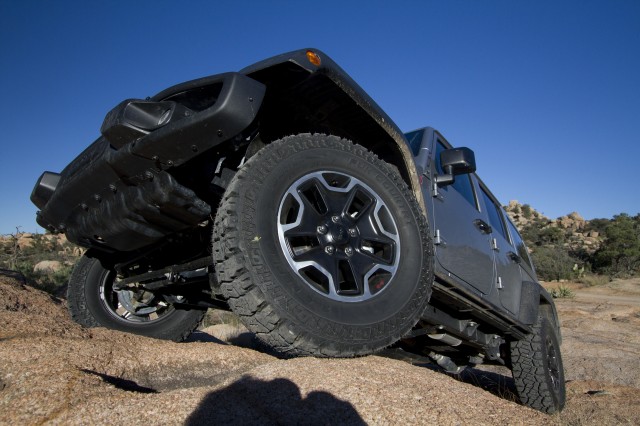

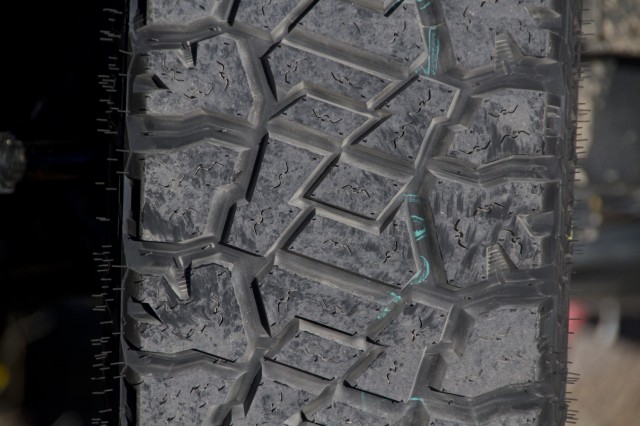


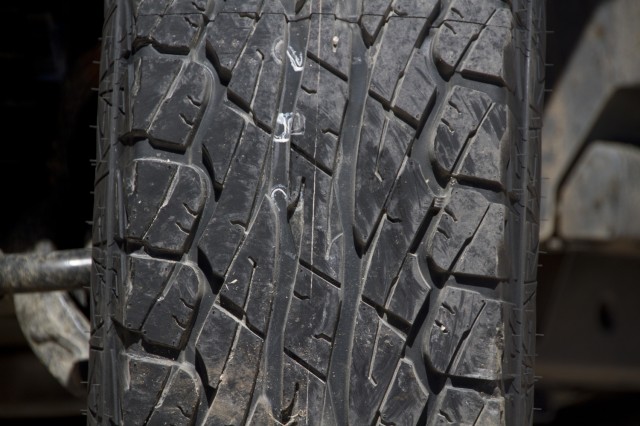

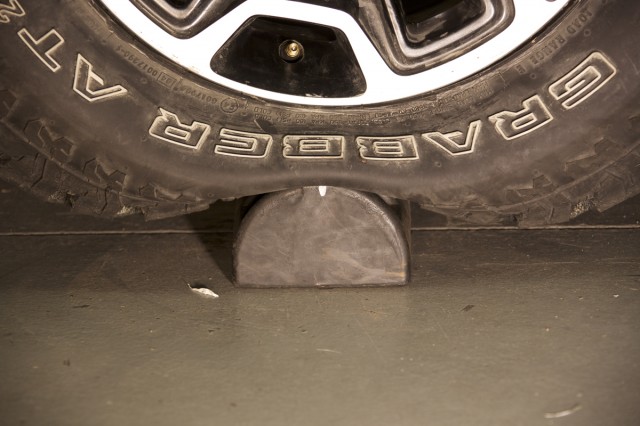
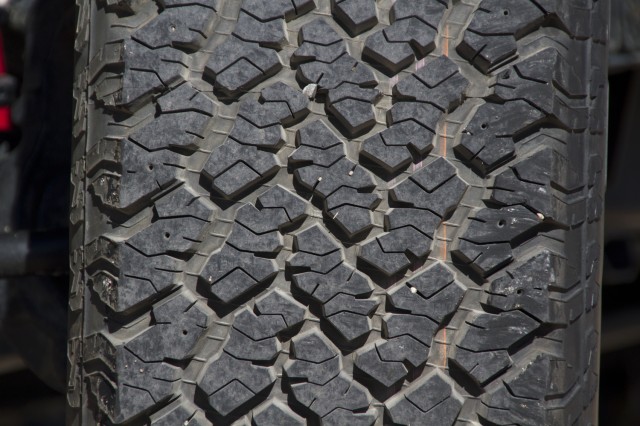


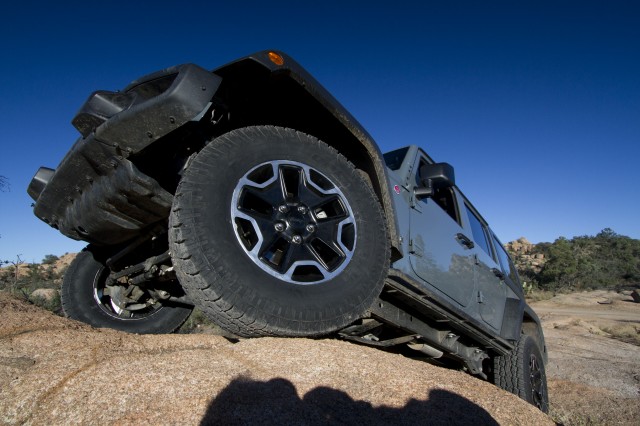

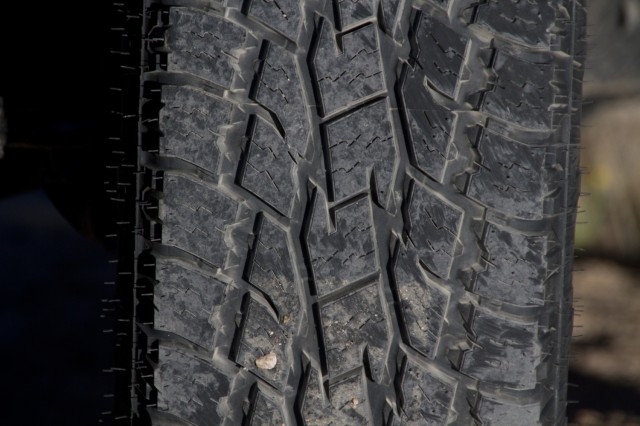


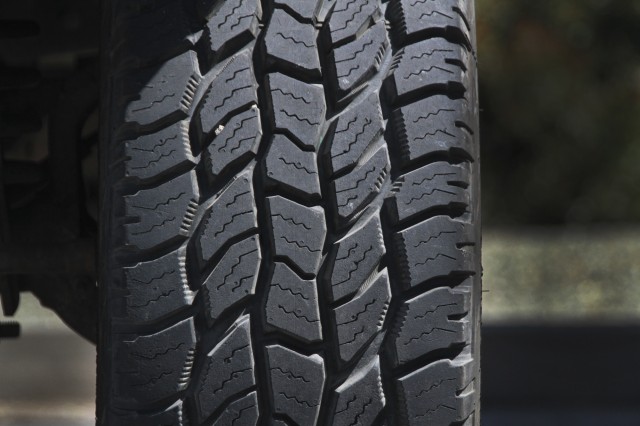
One Comment
Russell
March 8th, 2019 at 6:53 amTop tier review here, always come back to it. Have you guys done an updated version of this? Would be really beneficial to us if you could manage it.